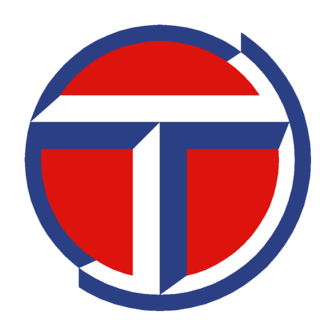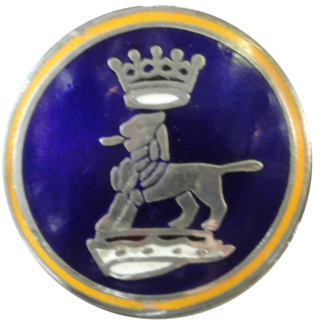Grand Prix motor racing, a form of motorsport competition, has its roots in organised automobile racing that began in France as early as 1894. It quickly evolved from simple road races from one town to the next, to endurance tests for car and driver. Innovation and the drive of competition soon saw speeds exceeding 100 miles per hour (160 km/h), but because early races took place on open roads, accidents occurred frequently, resulting in deaths both of drivers and of spectators. A common abbreviation used for Grand Prix racing is "GP" or "GP racing".

Talbot was an automobile marque introduced in 1902 by English-French company Clément-Talbot. The founders, Charles Chetwynd-Talbot, 20th Earl of Shrewsbury and Adolphe Clément-Bayard, reduced their financial interests in their Clément-Talbot business during the First World War.

Talbot-Lago was a French automobile manufacturer based in Suresnes, Hauts de Seine, outside Paris. The company was owned and managed by Antonio Lago, an Italian engineer that acquired rights to the Talbot brand name after the demise of Darracq London's subsidiary Automobiles Talbot France in 1936.

The 1950 Formula One season was the fourth season of the FIA's Formula One motor racing. It featured the inaugural FIA World Championship of Drivers, which commenced on 13 May and ended on 3 September, as well as several non-championship races. The championship consisted of six Grand Prix races, each held in Europe and open to Formula One cars, plus the Indianapolis 500, which was run to AAA National Championship regulations. Giuseppe Farina won the championship from Juan Manuel Fangio and Luigi Fagioli.

Sunbeam Motor Car Company Limited was a British automobile manufacturer with its works at Moorfields in Blakenhall, a suburb of Wolverhampton in Staffordshire, now West Midlands. Its Sunbeam name had been registered by John Marston in 1888 for his bicycle manufacturing business. Sunbeam motor car manufacture began in 1901. The motor business was sold to a newly incorporated Sunbeam Motor Car Company Limited in 1905 to separate it from Marston's pedal bicycle business; Sunbeam motorcycles were not made until 1912.
Baconin Borzacchini was an Italian Grand Prix motor racing driver often referred to as Mario Umberto Borzacchini.

The circuit Reims-Gueux was a Grand Prix motor racing road course, located in Gueux, 7.5 km west of Reims in the Champagne region of north-eastern France, established in 1926 as the second venue of the Grand Prix de la Marne. The triangular layout of public roads formed three sectors between the villages of Thillois and Gueux over the La Garenne / Gueux intersection of Route nationale 31. The circuit became known to be among the fastest of the era for its two long straights allowing maximum straight-line speed, resulting in many famous slipstream battles.

Emilio Materassi was an Italian Grand Prix motor racing driver.

Sir Henry O'Neal de Hane Segrave was an early British pioneer in land speed and water speed records. Segrave, who set three land and one water record, was the first person to hold both titles simultaneously and the first person to travel at over 200 miles per hour (320 km/h) in a land vehicle. He died in an accident in 1930 shortly after setting a new world water speed record on Windermere in the Lake District, England. The Segrave Trophy was established to commemorate his life.

Louis Auguste Wagner was a French Grand Prix driver who won the first ever United States and British Grands Prix. Wagner was also a pioneer aviator.

Jean Chassagne was a pioneer submariner, aviator and French racecar driver active 1906-1930. Chassagne finished third in the 1913 French Grand Prix; won the 1922 Tourist Trophy and finished second in the 1925 Le Mans Grand Prix d'Endurance - all in Sunbeam motorcars. He was second in the 1921 Italian Grand Prix with a Ballot, and set speed records and won races at Brooklands and hill climbs internationally.

Giulio Masetti was an Italian nobleman and racing driver, known as "the lion of Madonie" from his dominating the Targa Florio in the early 1920s.

The 1926 Grand Prix season was the second AIACR World Manufacturers' Championship season and the first running to new 1.5-litre regulations. The championship was won by Bugatti and its Type 35 was the dominant car of the year.

Kenelm Edward Lee Guinness MBE was a London-born racing driver of the 1910s and 1920s mostly associated with Sunbeam racing cars. He set a new Land Speed Record in 1922. Also an automotive engineer, he invented and manufactured the KLG spark plug. A member of the Guinness brewing family, and a director of the company, he lived and died in Putney Vale, London, and was buried at the nearby cemetery, bordering Putney Heath.

Clément-Talbot Limited was a British motor vehicle manufacturer with its works in Ladbroke Grove, North Kensington, London, founded in 1903. The new business's capital was arranged by Charles Chetwynd-Talbot, shareholders included automobile manufacturer, Adolphe Clément, along with Baron A. Lucas and Emile Lamberjack, all of France.

Antonio Franco Lago was an Italian engineer and motor-industry entrepreneur. In 1936 he bought Automobiles Talbot S.A. from his employers, the collapsed Anglo-French S.T.D. Motors combine, and founded the motor-racing marque Talbot-Lago.
Robert Brunet was a French racing driver between 1931 and 1951. Most of his 44 entries were Grands Prix, but he also entered the 24 Hours of Le Mans. He achieved a class victory and was fifth overall in the 1949 edition.

Automobiles Darracq France was a manufacturer of motor vehicles and aero engines in Suresnes, near Paris. The enterprise, known at first as A Darracq et Cie, was founded in 1896 by successful businessman Alexandre Darracq.

Automobiles Talbot France was the French subsidiary of British automotive manufacturer S.T.D. Motors Ltd., established in 1920 after the merger of British automakers A Darracq and Company, Clément-Talbot, and Sunbeam Company. Automobiles Talbot manufactured cars in Suresnes, near Paris.

The Talbot-Darracq 56 was a voiturette race a car, designed, developed and built by British-French manufacturer Talbot-Darracq, in 1921.
















